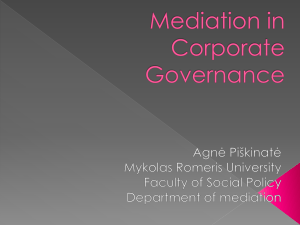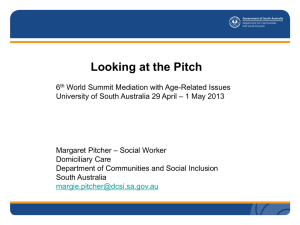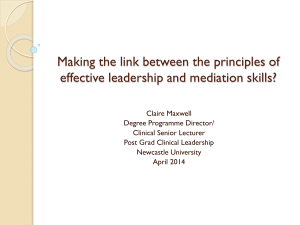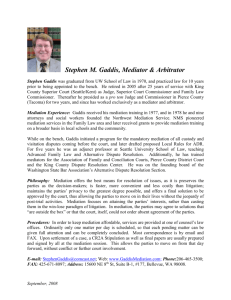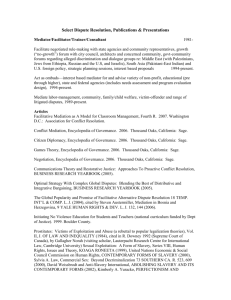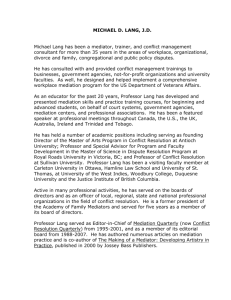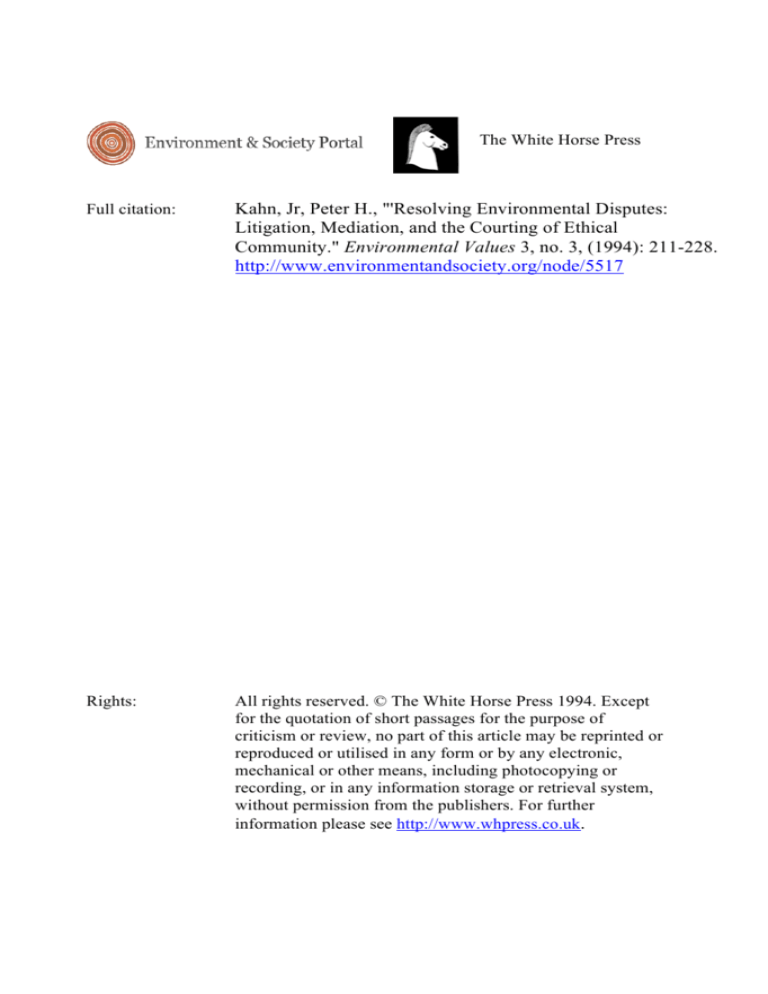
The White Horse Press
Full citation:
Kahn, Jr, Peter H., "'Resolving Environmental Disputes:
Litigation, Mediation, and the Courting of Ethical
Community." Environmental Values 3, no. 3, (1994): 211-228.
http://www.environmentandsociety.org/node/5517
Rights:
All rights reserved. © The White Horse Press 1994. Except
for the quotation of short passages for the purpose of
criticism or review, no part of this article may be reprinted or
reproduced or utilised in any form or by any electronic,
mechanical or other means, including photocopying or
recording, or in any information storage or retrieval system,
without permission from the publishers. For further
information please see http://www.whpress.co.uk.
Resolving Environmental Disputes: Litigation,
Mediation, and the Courting of Ethical Community
PETER H. KAHN, JR.
Education and Human Development
Colby College
Waterville, ME 04901, USA
ABSTRACT: Litigation and mediation offer substantive and important approaches toward resolving environmental disputes. Yet as currently practiced
both approaches have shortcomings. For example, litigation often promotes
divisive, adversarial relationships. Mediation often yields untenable ground
given the seriousness of many environmental problems. This paper offers a
reconception of both approaches. It is argued that both litigation and mediation
need to be embedded within a more ethically comprehensive context, one of
‘courting ethical community’. Discussion focuses on what it means in this sense
to court, on what defines and bounds the ethical, and how courting depends on
understanding not only differences but commonalities in people’s environmental views and values.
KEYWORDS: Community, environmental dispute resolution, environmental
ethics, litigation, mediation, moral psychology, morality
Technological and industrial activity has led to the increasing degradation of the
natural environment, locally and globally. As a result, environmental disputes
increasingly arise. Should an area be logged? A dam built? A marsh filled? A
toxic dump created? These disputes often become heated if not bitter. Witness,
for example, the recent disputes on the west coast of the United States over
whether large tracts of old growth timber should be logged. On one side stand
community members fighting for their jobs; on another stand environmentallyconcerned individuals fighting for the habitat of the spotted owl, and more
generally for the value of wilderness itself. How can, and indeed, how should,
such environmental disputes be resolved?
I take up this question by examining two approaches open to individuals and
organisations wishing to press their claims in environmental disputes: litigation
and mediation. Both approaches have not only advantages but shortcomings.
Thus the problem lies not so much with which approach to use, but with the way
both approaches are currently conceptualised and practiced. In particular, I focus
on mediation, which comprises a comparatively young and rapidly changing
Environmental Values 3 (1994): 211-28
© 1994 The White Horse Press, Cambridge, UK.
212
PETER H. KAHN, JR.
field. I draw on current work by myself and others in moral psychology to argue
that our vision needs to extend beyond behaviour alone to deep and abiding
common ethical concerns central to the human experience. From this basis
environmental dispute resolution can be embedded within a more ethically
comprehensive context, one that involves what I call in the title of this essay the
‘courting of ethical community’.
ENVIRONMENTAL LITIGATION AND MEDIATION
Almost everyone is familiar with the idea of litigation. If we have a legal
disagreement with somebody, or some business, industry, or governmental
agency, we can bring our dispute to the courts of law. Environmental and public
interest groups continue to do just that. They often try to prevent certain
industrial or governmental activities; and when damages do occur to the natural
environment, they try to press their claims in the courts for compensation.
There is increasing consensus, however, that litigation has drawbacks in
resolving environmental disputes. For example, because litigation is expensive,
it is often beyond the financial means of concerned individuals and organisations. Litigation is also very time-consuming. Cases in the courts can drag on for
many years before being settled.1 Moreover, part of what complicates environmental litigation is that for a judge or jury to decide on an issue under dispute,
it is often necessary to assess blame. Such assessments may well be possible in
criminal cases, such as ‘Did or did not Mr. Jones embezzle the money?’ But not
so in many environmental disputes. To what extent can a logging company, for
example, be held accountable for possibly endangering the spotted owl? Such a
question is particularly difficult to answer because the harmful consequences are
not actual historical events, but only predicted, based on incomplete or at least
controversial evidence.2
In addition to these problems lies perhaps an even more serious one.
Litigation engenders adversarial relationships. Such relationships often occur
even if the disputants reach a settlement out of court. Consider:
In a survey of Chicago litigators, more than three-quarters cheerfully admitted to
using various procedural tools to run up their opponents’ costs and keep them
scrambling to respond. One lawyer said: ‘I use [pretrial] discovery to hurt my
opponent...’ Another lawyer said: ‘The idea...is to “see if you can get [your opponent]
mad”’, putting them ‘through the wringer, through the mud’ so that ‘they are
frightened...’ 3
There are reasons why lawyers are the brunt of so many unkind jokes. Lawyers
litigate in ways that often make the losers feel angrier than ever at their
opponents. Distrust intensifies. Legal penalties often encourage business to
develop future evasion strategies, not remedies. Indeed, on either the business or
RESOLVING ENVIRONMENTAL DISPUTES
213
environmental end, even the winners in litigation often feel exhausted and angry
with the whole process.4
Given these problems with litigation, there has been increasing interest in
resolving environmental disputes through mediation. Historically, mediation
has its roots in the United States within labour-management negotiation, wherein
a neutral third-party person who has no power to impose a settlement helps
disputants to clarify issues and concerns, and to formulate through consensus
written concessions and settlements.5 In the last several decades, however,
environmental mediators have branched off in various directions, partly in
response to the added complexity of environmental issues. For example, unlike
in labour-management disputes, environmental disputes often involve many
disparate parties. In response, mediators have sometimes taken an active role in
deciding who has standing in a dispute. Moreover, mediators have sometimes
taken other active roles by providing specific alternatives that allow for win-win
solutions, seeking to break down stereotypic views each party holds of the other,
and seeking to intervene in conflictful situations before specific disputes arise.6
Because environmental mediation has resisted a singular practice or definition,
the term will be used broadly in this paper to mean any number of alternative
dispute resolution procedures that seek to achieve consensus between conflicting parties. Thus, in contrast to litigation, mediation embodies consensual rather
than adversarial processes.7
To provide a sense of this approach, consider a dispute that was mediated in
Seattle, Washington by Cormick and McCarthy.8 The case, in abbreviated form,
was as follows: The Snoqualmie River Valley in the Seattle area was prone to
heavy flooding. Farmers and other residents wanted protection through the
building of a dam on the main fork of the Snoqualmie River. Some years before,
such a dam had been proposed by the US Army Corps of Engineers. However,
a coalition of environmental and citizen groups prized the pristine wilderness of
the Snoqualmie River, and opposed any form of a dam. The Governor had twice
vetoed a dam on environmental grounds. But he finally recognised the need for
some form of flood protection.
Mediators were called in. One of their first tasks was to identify the parties
that had a stake in the outcome. Then they selected ten individuals who they
thought best represented the various constituencies. The mediators brought them
together. Over several months, many rounds of discussion followed that were
aimed to help the participants understand their opponents’ views. For instance,
environmentalists came to realise that the farmers wanted to keep their land, and
not sell it to developers. Farmers realised that environmentalists were concerned
not just with pristine wilderness, but urban sprawl. Similarly, residents began to
understand that uncontrolled growth would lead to the very degradation of the
area they so valued. Thus both farmers and residents began to acquiesce to land
use controls which restricted the use of farm land to agriculture and prohibited
development. In turn, environmentalists began to understand that while they
214
PETER H. KAHN, JR.
might be able to delay any dam for a prolonged period of time, any future
flooding which resulted in serious economic loss or physical injury could (a) lead
to a full scale dam project, and (b) damage their credibility in advocating future
environmental positions. Thus environmentalists began to agree to consider
some form of a dam. The bottom line was that consensus was reached to build
a dam on a smaller fork of the Snoqualmie river. The farmers and residents gave
up on full flood control protection, but they got some; the state got some
hydroelectric power; environmentalists got concessions on land use and development, and they protected the main fork of the Snoqualmie. End of dispute.
Based on such results, one can begin to see why mediation, in comparison to
litigation, can save money and time, and create partnerships rather than adversaries. Mediation can also provide a large measure of self-determination among
all the constituents, and thus lead to long-term resolutions of environmental
disputes.
But mediation also has its problems. For example, when mediations occur
between corporations and local neighbourhood groups, there are potential
problems based on power and negotiating expertise. Typically corporations have
both; local neighbourhood groups have neither. Thus there is the worry that
corporations will be successfully coercive in mediation. In addition, for mediations
to be manageable they are often limited to a few representatives of the major
lobbying groups. Thus there is the worry that while the special interest groups
may be satisfied with the result of the mediation, that the needs of the general
public can still be overlooked.9 It is also not clear that most environmental
disputes can be successfully mediated. At least so far, successful mediations
have tended to be on problems that have a fairly limited number of issues, where
all the parties believe that mediation can best serve their interests, and where
broad issues of public policy are not negotiated. Not all environmental disputes
meet these criteria. Perhaps not even most of them do.10
There is another problem with environmental mediation – a serious one in my
view – that receives relatively little attention in the literature. Some months ago
I was promoting the idea of environmental mediation to an environmental
activist and friend in Northern California. I argued that we needed to be
responsive to diverse constituencies, and that mediation provided a powerful
means toward that goal. I said something like, ‘Hey, we are all in this thing
together. It’s time we got past the idea of business interests versus environmental
interests, of the us-versus-them mentality. We have common interests. We need
to take care of the environment; we also need to promote business. Let’s work
together.’ My friend did not find my position so reasonable.
I object [to your idea]...to be responsive to diverse constituencies. I see it as somewhat
backward, and perhaps a reason why all our impressive environmental laws with their
glowing intentions have not halted the deterioration of the natural world. The state of
the environment can’t be altered to respond to diverse constituencies. The diverse
constituencies must change to respond to the needs of the environment. Otherwise we
RESOLVING ENVIRONMENTAL DISPUTES
215
degrade the environment, perhaps not in one fell swoop, but nevertheless, relentlessly, in small step by small step. One group opposes the air polluting incinerator.
The incinerator company backs off from their original plan, and they agree to pollute
the air only a little, rather than a lot. Is that progress?11
Her point is well taken. Consider again the mediation of the Snoqualmie
River Valley. That mediation is often cited in the literature as a classic success
story. But is it? Is it a success when through mediation yet another wild river gets
dammed? Step by step we lose the rivers. Step by step wilderness disappears, soil
erodes, fish die, species disappear, ozone depletes. In major cities people choke
on the polluted air when they go outside. It is rather daunting. It is especially
daunting when we consider how much environmental degradation has occurred
in such a short period of time. The last 20 years? The last 200 years? Thus when
looked at from this perspective, it is not clear that mediation is the best means to
resolve environmental disputes. Perhaps most projects that harm the environment need to be stopped outright.12 But, at this point, we are right back to
litigation, where we need to take up the disputes in the courts of law and try to
win cases.
So, what should we do? To start with, it should be recognised that the choice
is not between litigation or mediation. As articulated by Bingham:
Although environmental dispute resolution processes are often characterised as
alternatives to litigation – with the presumption that litigation is bad – [I
view]...voluntary dispute resolution processes as additional tools that may or may not
be more effective or more efficient in particular circumstances; litigation and other
traditional decision-making processes remain important options.13
Bingham is correct that both litigation and mediation offer viable approaches.
Moreover, both approaches would seem to complement if not strengthen one
another. Litigation, for instance, is often enhanced by drawing on mediation
techniques; and negotiated out-of-court settlements are often the result. Conversely, mediation often depends on litigation, or at least its threat. For example,
a senior staff attorney for the Natural Resources Defense Council has argued that
it is only ‘when industry perceives that it is going to get a worse deal without
negotiation that it negotiates’.14 Elsewhere, Blackburn argues that mediation is
enhanced when there is ‘uncertainty about possible outcomes of the dispute in
a context other than mediation, i.e., in the courts, before a regulatory body, etc.’15
This relationship between mediation and litigation seems to be borne out in
assessing the Snoqualmie River mediation described earlier. Each of the various
disputants (e.g., the farmers, residents, environmentalists, and state) anticipated
a worse deal if they had to litigate. But even if we accept that both litigation and
mediation offer viable and complementary approaches, we are still left with the
dilemma just articulated: both approaches have serious limitations and often
come up short in meaningfully resolving environmental disputes. More is
needed.
216
PETER H. KAHN, JR.
RECASTING THE THEORETICAL FRAMEWORK FOR
ENVIRONMENTAL DISPUTE RESOLUTION: DIFFERENCES AND
COMMONALITIES.
The Snoqualmie River settlement highlights a difficulty that occurs with many
environmental dispute resolutions. Each of the participants seeks maximum
satisfaction, and the settlement is achieved through compromise. It is a form of
deal-making. ‘I’ll give you this, if you give me that.’ Granted, especially through
mediated settlements, participants often come to understand each other’s views
better. But to understand is not the same as to respect, let alone to agree.
Accordingly, through such settlements participants can often feel like they have
compromised. It is an interesting word, compromise. Two edged. Sometimes it
is used positively, as in to give ground in a mature fashion. But there is also a
negative connotation to the word. It can mean not to live truly to one’s ideals and
principles, as in to compromise oneself. In this latter sense, settlements that
depend on compromise seldom fully satisfy participants.
Perhaps it will be said that little more than compromise in the latter sense can
be achieved in resolving environmental disputes, since the disputes arise because
of incommensurable differences in the views of the participants. For example,
Fietkau has argued that the bitter disputes over environmental issues, especially
where negligence and fixing blame are involved, are often based on two different
ways that individuals view solutions to environmental problems.16 One way
Fietkau says is held by many industrialists: that science and technology, and the
rapid implementation of new technologies, will solve the problems that arise. A
second way is held by many environmentalists: that changes are needed in
peoples’ lifestyles and in the reorganisation of the decision-making process.
Given such differences, can we expect more from environmental dispute
resolution?
I think so. But the focus needs to change. We need a theoretical framework
and a research program that seeks to articulate not only differences but
commonalities in individuals’ environmental views and values. From the basis
of common ground, mutual respect can emerge, sensitivities widen. Instead of
‘making one’s best deal’ the idea changes to achieving a shared vision on at least
some substantive dimensions, a meeting place where self-interest spills over into
other’s interest, a basis for mutual respect and genuine concern for the other. A
place of trust. Toward moving in this direction, I draw on several ideas from the
field of moral cross-cultural psychology that I have advanced elsewhere on how
to begin to find common moral ground across diverse cultures.17 Then I begin to
apply the ideas to resolving environmental disputes.
In moral cross-cultural psychology a basic question arises: Is the moral life
different or similar between cultures? Certainly, at first blush, there is evidence
for moral diversity. For instance, according to van der Post the Bushman of the
Kalahari Desert leave their elderly either to attack by animals or to sure
RESOLVING ENVIRONMENTAL DISPUTES
217
starvation.18 Elsewhere, Shweder, Mahapatra, and Miller have documented that
devout Hindus believe that it is immoral for a widow to eat fish, or for a
menstruating woman to sleep in the same bed with her husband.19 Such practices
and beliefs appear to differ dramatically from those of Western cultures.
But in analysing such anthropological data it is crucial to distinguish varying
levels of characterising the moral life. A simple analogy may prove helpful.20
Imagine that we are interested in clothing, and examine four men’s suits. One is
made of cotton, the second wool, the third polyester, and the fourth silk. Each is
also cut to a different size. We ask, are these objects the same? If we focus on their
material or size, the answer is no. But if we focus on the more abstract qualities
that make them all suits (such as their form and function), then the answer is yes.
In other words, depending on our level of analysis, there are both differences and
commonalities between these objects.
So, too, with morality. Depending on how morality is analysed one is led to
varying conclusions about moral diversity. For instance, unlike in Bushman
society, we do not leave our elderly to be attacked by wild animals or to starve
alone in the desert. Yet van der Post’s description goes beyond this behavioural
level. He also describes how the Bushman are a nomadic people, who depend on
mobility for their survival. Thus it is only when elderly people cannot keep up
with the nomadic pace – that is, when their immobility jeopardises the survival
of the entire group – that they are left behind. Moreover, it appears that the group
keenly feels the loss of their elderly. Group members have been seen to conduct
ritual dances in their honour, and to provide them with a temporary hut and a few
days worth of food: symbolic of the group’s care and concern. Thus, from van
der Post’s account of the Bushman’s motivations, social context, and environmental constraints, it appears much less that group members abandon their
elderly as much as part company under forced circumstances.
Such an analysis does not negate differences between Bushman and Western
cultures. On a behavioural level, both cultures do engage in different practices
regarding the care of their elderly. But the analysis also points to areas of moral
common ground. Notice, for example, that as many Western medical practices
become more extensive and extraordinarily expensive, we face the problem of
how to weigh the benefits to elderly patients with the corresponding costs to
society. The problem is sometimes starkly framed in terms of ‘who lives and who
dies’.22 It is a moral problem and an emerging resolution not unlike what
Bushman encountered and generated.
A similar analysis has been applied to other anthropological data. For
example, Turiel, Killen, and Helwig have reanalysed some of the data reported
by Shweder and his colleagues of Hindu culture.23 In their reanalysis, they point
out that the Hindu subjects, for example, believed that harmful consequences
would follow from a widow who ate fish (the act would offend her husband’s
spirit and cause the widow to suffer greatly). Similarly, devout Hindus believed
that harmful consequences would follow if a menstruating woman sleeps in the
218
PETER H. KAHN, JR.
same bed with her husband (the menstrual blood is believed poisonous and can
hurt the husband). While such beliefs about physical causality differ from those
in our culture, the underlying moral concern for the welfare of others is congruent
with our own.23
Based on this kind of analysis of differences and commonalities, the
following relation can be proposed: Definitions of morality which entail behaviours or rigid moral rules tend to highlight moral cross-cultural variation, while
definitions which entail abstract characterisations of justice and welfare tend to
highlight moral universals. It is this very relation I suggest that can be brought
into the area of environmental mediation.
To provide a start along this line of inquiry, consider a dispute between a
stereotypical conservative logger and an environmental wilderness advocate
about whether to log an old-growth forest that borders a wilderness area. Two
characterisations of differences can be provided. On a behavioural level the
logger and wilderness advocate have diametrically opposed positions. The
logger wants to log the forest. The wilderness advocate wants to preserve it.
Second, there are differences in their environmental judgments and values. The
logger largely brings forth a homocentric environmental orientation wherein
judgments about whether or not to protect the environment centre on how the
environment affects humans. From this perspective, for example, loggers often
argue that timber harvests should be promoted because they provide jobs and
economic vitality to local communities.24 In contrast, wilderness advocates
largely bring forth a biocentric orientation. Here it is often argued that the
environment itself deserves moral consideration because aspects of it (such as
animals, or even trees or landscapes) either have rights, or at least innate worth
independent of its value as a human commodity.25
This second characterisation – homocentric versus biocentric – highlights
differences. Yet by focusing on underlying welfare conceptions, the characterisation can also be seen to provide a basis for establishing common ground.
Notice, for example, that presumably the logger is concerned not with jobs per
se, but with jobs because jobs promote human welfare (his own included). Thus,
like in Bushman or Hindu society, we are likely to see the centrality of the welfare
concept in the logger’s moral and environmental orientation. In turn, we can seek
to build on those welfare considerations by showing how at least aspects of the
proposed logging activity seriously impact the short and long-term welfare of
humans. For instance, in many cases it can be shown that logging in the Pacific
Northwest will lead to serious soil erosion, which leads to poorer commercial
Salmon fishing (let alone poorer recreational fishing). Or if that is too otheroriented for any particular logger, it could be shown that without sustained yield
forest management the logger’s job will disappear, not tomorrow, but soon.26
The point is that in mediation loggers can potentially be moved to take more
seriously environmental concerns by building on their own deep homocentric
concerns for human welfare. Similarly, wilderness advocates can be moved to
take more seriously loggers’ concerns by building on the wilderness advocates’
RESOLVING ENVIRONMENTAL DISPUTES
219
own biocentric orientation. For notice that from a biocentric perspective a good
deal of human activity also counts as natural activity. What does this mean?
Consider one of the philosophically difficult environmental questions: Are
humans a part of nature or apart from nature? The biocentric answer is ‘some of
each’. In other words, picture two inter-connecting circles. A Boolean diagram.
One circle is homocentric, the other biocentric. The overlapping part of the
circles is where biocentrism is also homocentrism. Thus a biocentric position
takes seriously, the welfare not only of plants and animals, but of humans – of
loggers. Thus here again on the basis of human welfare we are in a position to
build common ground between loggers and wilderness advocates.
THE COURTING OF ETHICAL COMMUNITY.
I have suggested that a theoretical framework is needed in the field of environmental dispute resolution by which to understand not only differences but
commonalities in individuals’ environmental views and values. From this
junction, it is possible to articulate further what I take to be a more comprehensive way of understanding and resolving environmental disputes, in terms of
courting ethical community.
Consider the meaning of courting ethical community first for mediation. As
may already be clear, I do not believe a mediator should be completely neutral.27
Rather I follow Amy when he says that
the job of the mediator involves much more than merely increasing communication
between the disputants, or offering innovative solutions. Rather, much of their most
important work involves getting the disputants to abandon their own understandings
of the conflict and to accept a new set of assumptions offered by the mediator. In this
sense, environmental mediation is not simply a way of resolving environmental
conflicts, it is also a way of redefining the way we think about them.28
But I am hesitant to follow those like Susskind further when it is argued that
mediators often can and should wield ‘clout’. For example, Susskind extols one
mediation that involved a water treatment project in Colorado.30 The mediator
was the local congressman. All the members who partook in mediation understood that this congressman could influence future legislative decisions, either
for them or against. Thus the members had a stake in not currying the congressman’s disfavour. In this sense, the mediator, as a congressman, wielded clout. In
so doing, one can rightly worry that the ‘mediated’ settlement becomes tinged
too much with coercion, and thus can fall prey to many of the pitfalls of litigation,
particularly that the agreements will not have broad consent or lead to deep,
lasting solutions.30
Instead of wielding clout, I suggest the mediator court. I use the term courting
to connote a process whereby one seeks to persuade rather than coerce. It is not
unlike courting in the romantic sense. Imagine a man who is courting a woman.
220
PETER H. KAHN, JR.
Imagine that he says: ‘Well, if you marry me fine, if you don’t marry me that’s
fine, too. I’m just trying to present you with your options.’ No, in such courting
one seeks neither to remain neutral nor to compel by force, but to persuade. So,
too, in environmental mediation.
But persuade about what? Let me be clear here. I think mediators should, in
some form, be seeking to stop the unrelenting step by step environmental
destruction of our planet. Some people might respond by saying, ‘surely few
business people would agree’. But not so. For building on the idea of biocentrism,
I think a good deal of human activity is ‘natural’. Thus many technological and
industrial endeavours should continue to be supported. But we also need to
consider the health of the natural environment. In defining the Land Ethic, Aldo
Leopold says : ‘Health is the capacity of the land for self-renewal.’ Do our
technological and industrial activities allow for such renewal? If not, we have
serious problems. Elsewhere Leopold says: ‘A thing is right when it tends to
preserve the integrity, stability, and beauty of the biotic community.’31 Do our
technological and industrial activities tend to preserve, say, the integrity of an
ecosystem, let alone of the human race? If not, again we have problems.
Notice that I have established a broad definition of what counts as community. Community includes you. It includes me. Community includes conservative loggers and radical eco-warriors. Community includes all people – and then
extends even further to include animals, trees, rivers, oceans, landscapes,
wilderness.
I have also established a broad and what I believe to be a robust definition of
what counts as ethical. It is broad in the sense that I seek to include diverse ethical
considerations based on justice, welfare, and conceptions of the Good Life
(virtue ethics).32 It is robust in that I do not seek to specify exactly how these
considerations play out in a particular culture at a particular point in time. This
is where the earlier distinction between abstract and concrete characterisations
of the moral life is so critical. In different times and place, the abstract
considerations can lead to different normative decisions. For example, consider
the decision of whether to log a pristine old-growth National Forest. Given our
current level of environmental degradation, and the few remaining stands of oldgrowth timber left, it is likely that such logging would seriously undermine the
health and integrity of the biotic community. In contrast, this same act of logging
done 200 years ago may well have been unproblematic, for the harm to the
environment at that time would likely not have undermined the community’s
health and stability. The difference here can be thought of using the idea of
chemical toxicity. In the same way that the same amount of a chemical substance
(e.g., iron) can be beneficial, harmless, or deathly to a person depending on the
existing concentration level of that substance within the person, so can the same
environmental act (e.g., of logging) be harmful or not depending on the existing
health of the environment. It is for this reason that I frame the mediator’s role not
in rigid normative terms (to log or not to log), but as a courter who seeks to
RESOLVING ENVIRONMENTAL DISPUTES
221
increase people’s sensitivities and commitments to the health, welfare, and
integrity of the larger biotic community.
This is not to say, however, that a mediator should advocate all these ideas
directly. A courter is not the same as an outspoken advocate. How much one
seeks to extend any particular disputant depends on who they are and the specific
context of the dispute. For those of us who teach, we know this from our own
experience. Students come to us with different backgrounds, sensitivities,
interests, intelligence, knowledge, commitment to larger social issues, and so
forth. We seek to extend them all along such dimensions. But what we actually
do in our teaching partly changes with each student. One student might benefit
from a Socratic sort of dialogue: energetic, at times almost confrontational.
Another student might need our uninhibited encouragement to develop his or her
ideas, and any sort of dialectic just gets in the way, and so it is dropped. Thus,
as educators we are principled, yet flexible. Principled with regard to the
underlying educational goals, flexible in how those goals play out in a particular
student in a particular context.
This characterisation parallels my earlier analysis of how to understand
moral universality: that we tend to find moral universals when we look for deeper
principles that involve justice and welfare, and find moral variation in how such
moral principles play out in a particular culture at a particular point in time. Thus
I want to bring this whole way of viewing problems to mediation. While the goal
in mediation is to court ethical community, what we do and say will vary greatly
depending on the people and context.
Let me put this idea another way. In the advocacy literature, three distinctions
have been made. There is
party advocacy, in which the intervener acts on behalf of – and is usually paid by –
a particular party or parties; outcome advocacy in which the intervener acts on behalf
of a specific outcome or policy that the sponsor deems desirable...; and process
advocacy, in which an intervener acts to pull into place a process for dealing with the
conflict at hand and is impartial with respect to the parities involved and the
outcome.33
In certain ways, I am combining outcome advocacy and process advocacy. The
outcome is toward the health and stability of the biotic community. The process
is in terms of courting, which seeks to make the outcome compelling to others
on a voluntary basis, rather than by force.34
Given this perspective, some might say that I am proposing that the mediator
be biased. But I would resist this characterisation. In comparison, consider a
judge during a custody trial where a mother and father are arguing passionately
for rights to their child. True, a judge listens to the evidence ‘impartially’ and
makes decisions based partly on legal precedent. But underlying the judge’s
decision is an overarching concern for justice, for protecting the rights of both
parents, and for protecting not only the rights but especially the welfare of the
222
PETER H. KAHN, JR.
child. ‘What is in the best interest of the welfare of the child?’ the judge will often
ask. Few of us, however, would therefore say that the judge is biased. Indeed, the
appeal to ethical principles is precisely what allows the judge to transcend partly
his or her personal biases. So, too, with the role of the environmental mediator.
True, I am advocating non-neutrality. But this non-neutrality occurs – like for a
judge – only by virtue of its ethical stance, in terms of courting ethical
community.
Something that begins to look like what I am suggesting can be seen in a
recent approach by the Nature Conservancy to help protect the ecosystem of the
Texas Hill country.35 This area in South Central Texas is almost twice as large
as New Jersey, and is populated by 2.5 million people largely in the cities of
Austin and San Antonio. It is an area rich in ecological diversity, with some 70
species of animals and plants having been identified as rare or threatened. It is
an area of spectacular canyon lands, and limestone caves that help make up one
of the country’s largest and purest aquifers. It is also an area that is ecologically
sensitive, and becoming seriously degraded by human activity. The hill country
is increasingly experiencing urban expansion and development. Moreover, the
ranching over the decades continues to take its toll on the land, particularly
because it is done from a homocentric orientation of domination over the land.
As one Texas rancher has said, we ‘were raised on the idea that the Lord gave you
dominion over all, and that it was not only your right but your responsibility to
go out there and make America safe for domesticated animals and to eradicate
anything wild’.36 Such ranchers do not take kindly to ‘outsiders’ coming in and
saying what can and cannot be done to their land. Moreover, given that the Texas
Hill country comprises such an extensive landscape, it would not be feasible to
buy all the land necessary to protect it.
In response, the Nature Conservancy has embarked on a new conservation
project that embodies three strategies. The first is to promote as much as possible
the ecological health of the land where development is occurring. The second is
to preserve core reserves by directly buying ecologically critical areas. The third
is to surround these core reserves with enormous buffer zones that involve
human activities with low environmental impact. For example, some traditional
cattle ranchers have begun to change their ranching practices, while others have
successfully converted their land to ‘guest’ ranches that draw visitors precisely
because of the ecological vitality and diversity of the region. What unifies these
three strategies, and what allows such conservation efforts to be accepted by
groups traditionally hostile to them, is the guiding principle ‘to focus on the
entire inhabited landscape, not just individual species or even habitats. That
requires humans, too, to be treated as part of the ecosystem.’37 Thus here is the
view of biocentrism that includes both nature and people, and which extends
beyond the mediation of specific disputes to ethically-grounded consensual
agreements between diverse constituencies.
Another case in point. In 1989, the chief of the United States Forest Service,
Dale Robertson, sought to solve conflicts over how to use the federal lands along
RESOLVING ENVIRONMENTAL DISPUTES
223
the Middle Fork of Idaho’s Salmon River. He brought together people who
represented timber, oil, and mining, as well as various conservation groups. He
took them on a three-day trip down the Salmon river, and gave them an
assignment: ‘Work out their differences, and develop a management plan for
federal lands they could all accept.’38 By the end of their trip, participants
generated the idea of ‘Responsible Shared Use’. According to Robertson,
Responsible Shared Use refines the idea of multiple use by adding the condition
of responsibility. Robertson thinks this idea can provide an organising theme for
people to gather around. He asks: ‘How can we use the land together in a
responsible way? – as opposed to people saying, “I want all of this for my use,
and don’t want anyone else using any of it.”’39
Granted, there are limitations with Robertson’s perspective. If all the users
get together and agree to use the land ‘responsibly’ it is possible – some would
say likely – that they would agree to keep using the land in ways that, step by step,
ultimately degrade the land, if only over the course of decades instead of years.
But that is the downside. The upside is that the idea of responsibility (ethics if
you will) has become centrally part of the dialogue. Thus the stage is set for
discussion of what counts as responsibility. For instance, to whom should one be
responsible? To people in other parts of one’s country or in other countries who
may be affected by one’s decisions? To future generations who inherit our
legacy? To the land itself? In other words, while Robertson doesn’t go far
enough, he does move in the direction that I am suggesting, to bring ethics into
the dialogue that grounds discussion of land use management debates.
This move to wider participation of individuals in decision-making is indeed
part of a larger project: to increase democratisation, to involve citizens more
directly in decisions that will affect their lives. But there is a deep tension in this
move toward democratisation. On the one hand, increasing representation of
diverse (and perhaps previously oppressed) viewpoints allows for more fair and
comprehensive decisions. On the other hand, increasing diversity of representation can lead various factions into heated power struggles with other factions,
each battling the other for control of scarce resources. In the United States, for
example, the debate on ‘multiculturalism’ has sometimes led not to an increased
sense of community, but to bitter struggles to gain power. More vividly, the same
tension can be seen in the recent upheavals of Eastern Europe, where the drive
for ethnic representation has sometimes led to the brutal disregard of the rights
and physical well-being of ethnic groups different from one’s own.
How can one reconcile such a tension? In part, the answer is to reinstate the
centrality of seeking ethical commonality while recognising and often appreciating diversity. Thus yet again I highlight the importance of a theoretical
framework that emphasises not only ethical differences but commonalities.
Without this orientation – in environmental dispute resolution and, more
broadly, in the fabric of the larger society – power often becomes the only
arbitrator, achieved through violent means. With such an orientation, that
recognises others’ humanity, ethical community becomes more realisable.
224
PETER H. KAHN, JR.
I recognise that courting ethical community is not easy, and that sometimes
consensual processes will break down. Moreover, in terms of environmental
dispute resolution, I take seriously the critique discussed earlier that has been
leveled against my position: that progress is not achieved when through mediation the unrelenting step by step destruction of our planet continues. Thus I agree
that sometimes an adversarial approach is warranted, and that litigation has its
place in a society, procedurally and ethically. But even in litigation we should
seek to court ethical community. Recall the Chicago lawyers I quoted earlier who
strive to hurt their opponents, to put them through the wringer, through the mud,
so that they are frightened.40 That need not happen in litigation. In contrast,
consider the position advocated by a man who was well versed in politics and
confrontation:
I hate the system of government that the British people have set up in India. I hate the
ruthless exploitation of India even as I hate from the bottom of my heart the hideous
system of untouchability for which millions of Hindus have made themselves
responsible. But I do not hate the domineering Englishmen as I refuse to hate the
domineering Hindus. I seek to reform them in all the loving ways that are open to me.
My noncooperation has its roots not in hatred, but in love.41
Equally compelling, Gandhi says elsewhere: ‘It is often forgotten that it is never
the intention of a satyagrahi to embarrass the wrongdoer. The appeal is never to
his fear; it is, must be, always to his heart. The satyagrahi’s object is to convert,
not to coerce.’42 To convert, not to coerce. Or, in the terms of the present
discussion, to litigate when necessary, but still to separate the actions from the
person, and to respect and care for the other’s humanity even in the heat of
dispute. Such is a difficult venture, but one that can lead to ethically substantive
and lasting resolutions.
NOTES
An earlier version of this paper was presented as part of the Science Technology Studies
colloquia series supported by the Sloan Foundation, Colby College, February 1992.
Thanks are also extended to students of the Graduate Program of the National Audubon
Expedition Institute who discussed numerous points with me during our research
seminars, 1992, 1993.
1
For further discussion of the limitations of environmental litigation based on financial
costs and time, see Bacow and Wheeler 1984; Amy 1987; Mills 1990; Holznagel 1986.
2
On a specific case level, notice that in the New York Times (9 Jan. 1992, p. A14) it was
reported that the Bureau of Land Management asked to be allowed to log ‘4,500 acres of
Federal land in western Oregon on which fewer than 50 owls depend. Fewer than 500 of
the birds are left in existence.’ Even when assuming that the specific numbers were
accurate, controversy arose over whether losing 50 out of 500 owls constituted a threat
RESOLVING ENVIRONMENTAL DISPUTES
225
to that species. For further discussion on the particular complexities of environmental
litigation, see, e.g., Thompson 1985; Cicchetti and Haveman 1988.
3
Olson 1991.
4
For further discussion on these issues, see, e.g., Blackburn1988; Olson 1991; Thompson
1985.
5
See e.g., Lentz 1986; Amy 1987.
6
See e. g., Lake 1980; Stulberg 1981.
7
It is true that in addition to litigation and mediation a third approach could be
characterised in terms of political action. Yet political action as a process often leads to
either litigation or mediation (or more generally a consensual agreement). For instance,
through political action environmental laws are created, and these laws set up the
litigation that follows. In turn, through political action consensus is often sought and
achieved. See, for instance, an unpublished manuscript by Robert D. Bullard, ‘Environmental Dispute Resolution in Communities of Color’. Bullard examines the strategies
nine activist groups in communities of colour have used to cope with serious threats of
environmental degradation to their communities. While the groups could be thought of
as political groups in the sense that they were seeking to influence public policy, directly
or indirectly, Bullard notes the following: that six of the nine groups used litigation as a
central tactic. The other three groups were part of a dispute resolution process.
8
Cormick and Patton, 1980. In this article, the authors also describe another dispute they
successfully mediated that involved building a proposed highway project in the Seattle
area.
9
See, e. g., Amy 1987; Blackburn 1988; Stanfield 1986.
10
As a case in point, consider an attempted mediation that involved the Phohl Brothers
landfill in Cheektowaga, New York (Nakamura et al. 1991). This landfill contained toxic
wastes that needed clean up. The federal government tried to establish legal liability for
the toxic waste, but they encountered protracted legal resistance and retaliation from the
potentially responsible parties (PRPs). In response, the New York State Business Council
sought to side-step the expense and time of litigation by bringing together the PRPs, with
the aid of a mediator. The goal was for the PRPs to formulate a plan for cleaning up the
site, and to allocate the costs for the clean up among themselves. However, after repeated
efforts, the group could not even get so far as to assess the dimensions of the problem or
the range of possible solutions. Indeed, they could not even agree to pay to build a fence
around the toxic site, despite the minimal costs involved. The PRPs complained that only
those parties who had voluntarily stepped forward to participate in the mediation would
be held accountable. The state did not seek to pressure other groups ‘hiding in the weeds’
to participate. In addition, the PRPs believed that any agreement to pay costs could
establish liability in any future legal action against them. This concern was never
mitigated, for the state had explicitly rejected federal participation in the mediation, and
the state, for political and legal reasons, did not want to grant waivers. The end result was
that mediation was not successful in resolving this environmental dispute.
11
Ellen Drell, personal communication.
12
For many people, this position is clearly the case already for environmental issues with
potentially severe impact on human welfare. For example, see Holznagel 1986, where it
is shown than in Massachusetts ‘five developers had sought to locate hazardous waste
facilities in the state. By 1985, each attempt had failed’ (p. 377). In these situations, it
appears that incremental threat of harm is large enough to prevent any compromise
position.
226
13
PETER H. KAHN, JR.
Bingham 1986.
Quoted in Stanfield 1986, note 9, p. 2766.
15
Blackburn 1988, note 4.
16
Fietkau 1988.
17
Kahn 1991.
18
van der Post 1958.
19
Shweder, Mahapatra and Miller, 1987.
20
I have modified an example used by Langer (1937).
21
For a review of eight recent books on medical ethics, see Rothman 1992.
22
Turiel, Killen and Helwig, 1987.
23
For a similar perspective on analysing cross-cultural variation and similarities see
Hudson 1991.
24
For a vigorous defence of the homocentric perspective, see Baxter 1986.
25
For a rights-based defence of biocentrism, see, e. g., Regan 1983; and Stone 1986. For
a more experiential defence of the inherent worth of nature, see e.g., Kohak 1984; Dean
1992; Leopold 1949; Rolston 1989.
26
A case in point: For many years, Louisiana Pacific argued that they needed to be able
to gain access and log National Forests in the countryside surrounding Covelo, California.
They often argued their case on the grounds that the economic prosperity of the town
depended on this ‘balanced’ use of the country’s national resources, and that environmentalists did not care about the well-being of the local townspeople. Most of the time their
arguments prevailed. In recent years, however, their ‘sustained yield’ management
approach has resulted in very little timber left to log in the area. Louisiana Pacific closed
down their Covelo mill. The end result is an environmentally devastated countryside, and
the same economic down turn for the local townspeople that had been feared a decade or
so earlier.
27
For further contrast, see Lentz 1986 Note 5, p. 139, where he argues that the mediator
must remain true to the ‘standards of party autonomy’ as established in traditional labourmanagement mediations. Yet, to question further the ideal of labour-management
negotiation as a model for environmental mediation, one but need ask: Are the relations
between GM and its workers – which Lentz extols – really an ideal?
28
Amy 1987, 163-164.
29
Susskind 1981.
30
Stulberg, note 6, similarly has problems with Susskind’s view that mediators should
wield ‘clout’.
31
Leopold 1949, note 26, pp. 258, 262, respectively.
32
In effect, these ethical considerations are responsive to two different views on moral
theory. One view, which includes both deontology and consequentialism, focuses on a
theory of the Right, and asks the question, ‘What does morally right action consist of?’
See, e.g., Kant 1785, and, more recently, Rawls 1971. The other view focuses on a theory
of the Good, and asks the question, ‘What does it mean to be a morally good person?’ See,
e.g., Aristotle’s Nichomachean Ethics, and, more recently, Macintyre 1984. For further
discussion of how to understand the place of these diverse views in the moral-developmental literature, see Kahn 1991, note 18. For an example of how moral considerations
based on deontology, consequentialism, and virtue theory can be brought together in
psychological research, see Kahn 1992.
33
Lentz (1986: 133) is here characterising the distinction made by Laue 1982.
34
For a thoughtful discussion of how similar ideas – based on her account of caring – can
14
RESOLVING ENVIRONMENTAL DISPUTES
227
and should ground interpersonal and professional relationships, see Noddings 1984.
35
For a general description of the Nature Conservancy’s project, see Stevens 1992.
36
Stevens 1992, note 36, C8.
37
Stevens 1992, note 36, C1.
38
Weegar 1993, p. 12.
39
Quoted in Weegar 1993, note 39, p. 13.
40
Olson 1991, note 3.
41
Quoted in Easwaran 1978, p. 56.
42
Quoted in Easwaran 1978, note 42, p. 53.
REFERENCES
Amy, Douglas J. 1987. The Politics of Environmental Mediation. New York: Columbia
University Press.
Bacow, Lawrence S. and Wheeler, Michael 1984. Environmental Dispute Resolution.
New York: Plenum.
Baxter, William F. 1986. ‘People or Penguins’, in D. VanDeVeer and C. Pierce (eds),
People, Penguins, and Plastic Trees, 214-18. Belmont, CA: Wadsworth.
Bingham, Gail 1986. ‘Resolving Environmental Disputes: A Decade of Experience’,
Resolve 17: 1.
Blackburn, J. Walton 1988. ‘Environmental Mediation as an Alternative to Litigation’,
Policy Studies Journal 16: 562-74.
Cicchetti, Charles J. and Haveman, Robert H. 1988. ‘Environmental Litigation and
Economic Efficiency: Two Case Studies’, in V. K . Smith (ed ), Environmental
Resources and Applied Welfare Economics: Essays in Honor of John V. Krutilla, 23760. Washington, DC: Resources for the Future.
Cormick, Gerald W. and Patton, Leota K. 1980. ‘Environmental Mediation: Defining the
Process through Experience’, in Laura M . Lake (ed ), Environmental Mediation: The
Search for Consensus, 76-97. Boulder, CO: Westview.
Dean, Barbara 1992. ‘Hunting a Christmas Tree’, Orion 11: 9-15.
Easwaran, E. 1978 Gandhi the Man. Tomales, CA: Niligri.
Fietkau, Hans-Joachim 1988. ‘The Role of Industry in the Environmental Policy Arena’,
in D . Canter, M. Krampen , & D. Stea (eds), Environmental Policy, Assessment and
Communication, 99. Brookfield: Avebury.
Holznagel, B. 1986. ‘Negotiation and Mediation: The Newest Approach to Hazardous
Waste Facility Siting’, Boston College Environmental Affairs Law Review 13: 32978.
Holznagel, Bernd 1986. ‘Negotiation and Mediation: The Newest Approach to Hazardous Waste Facility Siting’, Boston College Environmental Affairs Law Review, 13:
329-378.
Hudson, Yeager 1991. The Philosophy of Religion. Mountain View, CA : Mayfield.
Kahn, Peter H., Jr. 1991 ‘Bounding the Controversies : Foundational Issues in the Study
of Moral Development’, Human Development 34: 325-40.
Kahn, Peter H., Jr. 1992. ‘Children’s Obligatory and Discretionary Moral Judgments’
Child Development 63: 416-30.
Kant, Immanuel 1785/1964. Groundwork of the Metaphysic of Morals, trans. H. J. Paton.
New York: Harper Torchbooks.
228
PETER H. KAHN, JR.
Kohak, Erazim 1984. The Embers and the Stars: A Philosophical Inquiry into the Moral
Sense of Nature. Chicago: University of Chicago Press.
Lake, Laura M. 1980. ‘Characterizing Environmental Mediation’, in Laura M. Lake (ed.),
Environmental Mediation: The Search for Consensus, 58-75. Boulder, CO: Westview.
Langer, S.K. 1937/1953. An Introduction to Symbolic Logic. New York: Dover.
Laue, J. 1982. ‘Ethical Considerations in Choosing Intervention Roles’, Peace and
Change: A Journal for Peace Research 8: 29-42.
Lentz, Sydney S. 1986. ‘The Labor Model for Mediation and its Application to the
Resolution of Environmental Disputes’, The Journal of Applied Behavioral Science
22: 127-39.
Leopold, Aldo 1949/1970 A Sand Country Almanac. New York: Ballantine Books.
MacIntyre, Alasdair 1984. After Virtue. Notre Dame: University of Notre Dame Press.
Mills, Miriam K. (ed) 1990. Conflict Resolution and Public Policy. Westport, CT:
Greenwood Press.
Nakamura, Robert T., Church, Thomas W., Jr., and Cooper, Philip J. 1991. ‘Environmental Dispute Resolution and Hazardous Waste Cleanups: A Cautionary Tale of Policy
Implementation’, Journal of Policy Analysis and Management 10: 204-21.
Noddings, Nel 1984. Caring : A Feminine Approach to Ethics and Moral Education.
Berkeley: University of California Press.
Olson, Walter 1991. ‘Better Living through Litigation?’ The Public Interest 103: 84.
Rawls, John 1971. A Theory of Justice. Cambridge: Harvard University Press.
Regan, Tom 1983. The Case for Animal Rights. Berkeley: University of California Press.
Rolston, Holmes, III 1989. Philosophy Gone Wild. Buffalo, NY: Prometheus Books.
Rothman, David J. 1992. ‘Rationing Life’, The New York Review of Books, 5 March: 3237.
Shweder, Richard A., Mahapatra, M. and Miller, Joan B. 1987. ‘Culture and Moral
Development’, in J. Kagan and S . Lamb (eds), The Emergence of Morality in Young
Children, 1-82. Chicago: University of Chicago Press.
Stanfield, R.L. 1986. ‘Resolving disputes’, National Journal 18: 2764-68.
Stevens, William K. 1992 ‘Novel Strategy Puts People at Heart of Texas Preserve’, The
New York Times, 31 March, Cl, C8.
Stone, Christopher D. 1986. ‘Should Trees have Standing? – Toward Legal Rights for
Natural Objects’, in D. VanDeVeer and C. Pierce (eds), People, Penguins, and Plastic
Trees, 83-96. Belmont, CA : Wadsworth.
Stulberg, Joseph B. 1981. ‘The Theory and Practice of Mediation: A Reply to Professor
Susskind’, Vermont Law Review 6: 85-117.
Susskind, Lawrence 1981. ‘Environmental Mediation and the Accountability Problem’,
Vermont Law Review 6: 1-47.
Thompson, Andrew 1985. ‘Bargaining with the Environment: The Limits of Legal
Regulation’, in Augustine Brannigan and Sheldon Goldenberg (eds), Social Responses to Technological Change, 39-56. Westport, CT: Greenwood Press.
Turiel, Elliot, Killen, Melanie and Helwig, Charles C. 1987. ‘Morality: Its Structure,
Functions and Vagaries’, in J . Kagan and S. Lamb (eds), The Emergence of Morality
in Young Children, 155-244. Chicago: University of Chicago Press.
van der Post, Laurens 1958/1986. The Lost World of the Kalahari. New York : Harcourt
Brace Jovanovich.
Weegar, Andrew K. 1993. ‘The Future Forest: Former Competitors for its Resources
Agree to Share’, Maine Times, 22 January: 12.


